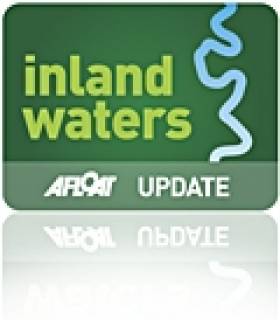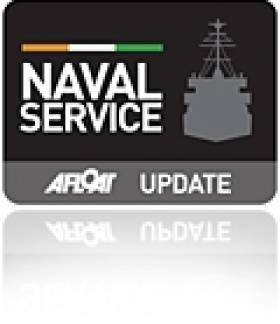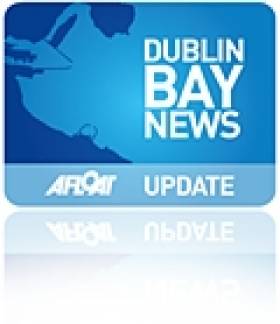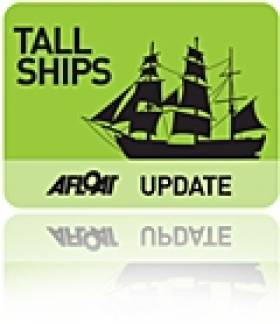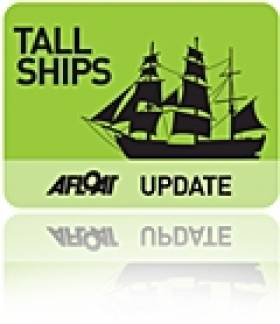Displaying items by tag: TallShips
Fun for All Ages…Tallships and ‘Ducking’ in the Docklands
#DUCKING DOCKS - Who will have the best looking duck swimming in the Duck Race?...at the Duck Your Duck Workshop this Saturday 25th August (between 11am-5pm –both Sat. & Sun). The children's creative workshop will be held at the Waterways Visitor Centre, Grand Canal Dock, Dublin.
There will be glitter and glue, paint and polish. So come on down and give your duck some character before it joins the Duck Race. Plus radio controlled boats, Watery Stories and the Darklight Kids' Programme.
In addition there will be plenty of other events and activities for all ages, organised as part of National Heritage Week, for more click HERE.
Also of course to boarding the tallships, with more than 40 such majestic vessels lining both sides of the Liffey quays. Also laid on are shored based events at both the Grand Canal and Spencer Docks. To see the free family festival programme over the four days click visit www. dublintallships.ie/
Fun for the Kids: Peg People-Create Your Own Character!
#PEG PEOPLE - This weekend's (18-19 August) children's arts and craft morning workshop is as usual been held in the Waterways Visitor Centre located in Dublin's Grand Canal Dock. Noting the centre has also organised other events and activities as part of National Heritage Week and with the Tallships (23-26 August) coming to town!
The theme of the creative morning is 'Peg People-Create Your Own Character With Textiles and a Wooden Peg! The activity is part of an on-going Children's Summer Workshop Programme, held every weekend until late August. On each of the weekends (both mornings), the theme of the art & craft workshop will change.
Art & craft workshops are to cater for two age groups with the first workshop (5-7 year olds) starts at 11:00 and the second session for those (aged 8-10) begins at 12 noon.
Admission is €3.00 per child, all children must be accompanied by an adult. Places are limited so booking is advisable. For further details contact: (01) 6777510, Wed-Sun 10.00am- 6.00pm and by visiting www.waterwaysirelandvisitorcentre.org/events.aspx
It is only in recent years that larger vessels can berth at this stretch of the waterfront following the completion of several major construction projects over the last decade. From the building of the Convention Centre and the Samuel Beckett Bridge which involved using the dredger Hebble Sand (click HERE) during its construction process.
In addition the refurbishment of Spencer Dock sea-lock entrance that for many years was closed is now re-opened. The dock entrance featured in the start of the new television series 'Waterways'-The Royal Canal. Episode two is this Sunday on RTE 1 at 8.30pm.
Aside the 79m L.E. Roisin, the last large vessel to berth close to berth 16A was the French 58m tallship Belem, which was chartered by Alliance Francaise to celebrate their 50th anniversary in 2010 and for the inaugural French Hoist the Sail: Market Festival. The three-masted barque built in 1896 was once also owned by the Sir Arthur Ernest Guinness under the name of Fantôme II.
Situated between where L.E. Roisin is currently berthed and where the Belem had moored, is home to the 'resident' M.V. Cill Airne, a floating bar and restaurant dining venue at berth 16B. Another resident is the former lightship Kittiwake at berth 17B, though sited much further downstream at the end of North Wall Quay, opposite the O2 Arena and next to the East-Link Bridge.
There is a fourth resident, again berthed on the north quays, though the Jeanie Johnston unlike her counterparts is moored closer to the city-centre at Custom House Quay. Apart from yachts, leisure-craft and occasional private motor-yachts using the Dublin City Moorings, she is the only vessel to permanently occupy a berth between Samuel Beckett Bridge and the Sean O'Casey foot-bridge.
- inland waterways
- Dublin Port
- Dublin Docklands
- Royal Canal
- Jeanie Johnston
- naval service
- Custom House Quay
- Alliance Française
- Spencer Dock
- Sean O'Casey Bridge
- River Liffey
- Belem
- Sir John Rogersons Quay
- TallShips
- North Wall Quay
- Fantome II
- Dick Warner
- Dublin City Moorings
- Navy News
- O2 Arena
- EastLink bridge
- LE Roisin
- Sir Arthur Guinness
- National Convention Centre Dublin
- Samual Beckett Bridge
At the same time across Dublin Bay, the Norwegian square-rigged tallship Statsraad Lehmkuhl was underway from her River Liffey berth at Sir John Rogersons Quay, where the 321" foot vessel had made a two-day visit to Dublin Port.
As the public boarded one of the largest tallships in the world, they were given a taste of what to expect a year from now, as the capital prepares to be the host-port of the final race-leg of the Tall Ships Races. The sailing spectacle was last held in 1998 and the high-profile event in August 2012 is expected to draw around 100 tallships.
Norwegian Tallship Opens to the Public in Dublin Docklands
The arrival of the largest and oldest Norwegian tallship the barque S/S Statsraad Lehmkuhl into Dublin Port yesterday made for an impressive sight, even without her sails set, writes Jehan Ashmore.
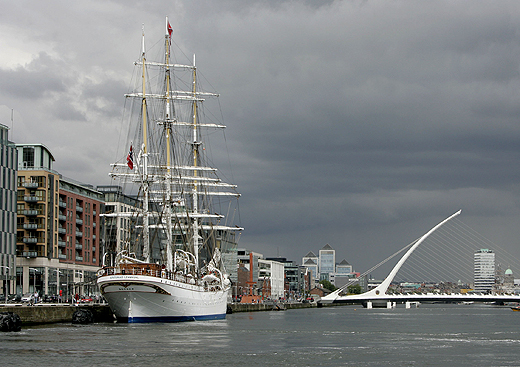


Her arrival marks nearly a year in advance to Dublin City welcoming the return of the Tall Ships Races, presented by Szczecin and organised by Sail Training International. The capital last hosted the event in 1998 and next year up to 100 tall ships are to sail into the capital which will be the final host port for four days between 23rd-26th August 2012.
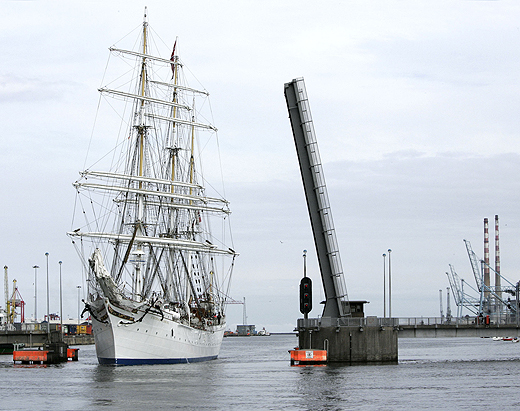
Tall Ship S/S Statsraad Lehmkuh in Dublin Bay yesterday. Images: Iain White
The celebration of sail is expected to draw entrants from as far away as Chile, Mexico, Argentina, USA and European and Baltic countries including Italy and Norway will chart their course to Dublin. It is hoped that the event will attract over a million visitors to the city, topping the 500,000 spectators who thronged the Waterford quays during this year's tall ship race gathering.

Photo: Jehan Ashmore
Dunmore East Bids TallShips Farewell
As the Russian 'A' class Mir passed the LE Aoife off Dunmore East in mid-morning, the largest tall ship of the festival headed the start of the Parade of Sail, writes Jehan Ashmore.
Crowds left their cars in fields outside Dunmore East and descended into the harbour and surrounding headlands to witness the highlight of the four-day festival. Adding to the scene were the numerous leisure-craft, yachts and intrepid kayakers that gathered to greet the procession which took some two hours to pass the fishing harbour.
No sooner had the fully-rigged ship Mir had slipped beyond the anchored naval vessel that the gaff schooner Johanna Lucretia, under full sail came closer into view. She was closely followed by the Ocean Youth Trust Scotland's Bermudan cutter Alba Explorer.

The Russian 'A' class Mir passing the LE Aoife off Dunmore East. Photo: Jehan Ashmore
Of all the 45 tallships participating the Columbian Navy's barque ARC Gloria presented the most colourful entrant. She proudly flew a large horizontal tricolor of yellow, blue and red representing the South American nation.
When it came to the turn of the Europa to pass the LE Aoife, the tug Bargarth gave a wonderful send-off with the traditional display of water jets shooting sky-high, nearly reaching the top of the three-masted barque.
Marking the tail-end of the parade was the Jubilee Sailing Trust's Lord Nelson, another barque that departed the estuary with the Hook Head Lighthouse forming a majestic backdrop.
At this stage several of the large tallships could be seen on the far horizon in preperation to the start of the first race leg of this years Tall Ships Races....next port of call Greenock!
- Waterford
- ship
- Dunmore East
- Lord Nelson
- Waterford Estuary
- LE Aoife
- Sail Training International
- Jubilee Sailing Trust
- Tug
- Hook Head
- Tall
- JOHANNA LUCRETIA
- TallShips
- Waterford Harbour
- JST
- Europa
- Fullyrigged ship
- STI
- ARC Gloria
- Hook Head Lighthouse
- Mir
- Gaff schooner
- Ocean Youth Trust Scotland
- Bermudan cutter
- Alba Explorer
- Columbian Navy barque
- Bargarth
- Fastnet Shipping
It's Official: Third Time Tallships for Waterford
Scenes of the tallships moored alongside the north and south quays and the surrounding festivities are captured by Gary O'Mahony. SCROLL DOWN FOR PICS.

The Columbian Navy's Sailing Training Ship ARC Gloria. Photo: Jehan Ashmore
This is the second year in which the city has been the host port of the Tall Ships Race and the prestigious event is to return for a third time. The next occasion has not been confirmed but it would be several years away according to Sail Training International, the organisers of the famous race.
Waterford: Where Tallships and Science Meet
This was the RV Keary's first INFOMAR survey leg of 2011 and it was also the first time that both vessels have worked in tandem. The mapping of the estuary was from an area just west of the city's Rice Bridge to the open sea at the mouth of Waterford Harbour.
The estuary was mapped before in 2007 using the Marine Institutes larger vessel the RV Celtic Voyager, which covered the harbour approaches from the 10m contour to greater depth offshore. Both RV Keary and RV Geo overlapped their coverage with this previous data, producing a comprehensive and seamless seabed map of the area.
RV Keary is constructed of marine grade aluminium and was custom built in 2008 for the (GSI) by Veecraft Marine of Capetown, South Africa.
The 15m craft with a draft of just 2m is equipped with an extensive range of highly sophisticated technology. She has an open working area at the aft-deck to conduct operations and is licensed to carry up to 12 personnel. For further vessel characteristics click HERE.
The 34-tonne craft made her 7,000 mile delivery voyage from the African continent to Europe. She was firstly transported on the deck of a cargoship to Rotterdam. After unloading at the Dutch port the 22-knot capable craft set off with several calls along the UK south coast to include loading bunkers before finally reaching Dun Laoghaire, from where she entered service in April 2009.
Alliance Franҫcaise de Cork and Fondation Belém in association with the Port of Cork are pleased to announce arrival of the French tall-ship fleet, Belém, a 116-year old barque at one stage owned by the Guinness family, writes Jehan Ashmore.
During her four-day stay the pride of the French tall-ship fleet is to berth at Albert Quay, in the heart of Cork city-centre where the public can thread her timber decks on Saturday (2 July) between 11.30-17.00 hours and on Sunday (3 July) starting from 10.00 till 18.00 hours. There is an admission of €5 for adults, a concession of €3 and a family ticket costs €10.
Visitors can trace her long and varied career with an exhibit housed below decks of the historic vessel which was built in 1896 in Nantes. For nearly two decades she crossed the Atlantic transporting a diverse cargo but mostly spices, sugar and cocoa beans from her namesake port of Belém do Pará, on the north-east coast of Brazil bound for France. She would sail upriver on the River Seine to supply the cocoa beans for a Paris-based chocolate-maker.
Belem would later become under the British flag and she became the property of the Duke of Westminster, who converted her to a luxury pleasure yacht. In 1921 she was sold to the Hon. Arthur Ernest Guinness, who renamed her Fantôme II and took part in the Cowes regattas and cruised around the world between 1923 and 1924 with his family.
To read more on the vessel's other career's under several owners until her present-day role as a sail-training vessel operated by the Fondation Belém click HERE and also www.portofcork.ie
In addition to visitors boarding the Belem, the public are invited to attend free readings by the Cork poets William Wall and Thomas McCarthy. Accompanying the poets are French writers Maylis de Kerangal and Olivier Sebban for a session of Franco-Irish readings which too takes place on the Saturday evening between 18.00 -19.30 hours.
For further information contact Vytenė Laučytė, Cultural Coordinator, Alliance Franҫaise de Cork Tel: (021) 431 0677 or by email: [email protected]
All advance bookings for the visit on board the Belem are to be made at Alliance Franҫaise de Cork. Tickets are also available at the entrance to the tallship alongside Albert Quay, Cork. Last year Alliance Francaise celebrated its 50th anniversary
- Cork Harbour
- port of Cork
- Brazil
- Alliance Française
- Cork Harbour News
- Paris
- Belem
- Arthur Ernest Guinness
- Cocoa
- TallShips
- Albert Quay Cork
- Fondation Belem
- Tall Ships news
- Duke of Westminster
- Guinness
- Paris chocolate makers
- Fantome II
- William Wall
- Thomas McCarthy
- Cork poets
- French writers
- Maylis de Kerangal
- Olivier Sebban
Brando’s ‘Bounty’ Bound for Bloomsday
The tallship used in the 1962 film of 'Mutiny and the Bounty' starring Hollywood screen legend Marlon Brando is to make a Bloomsday arrival to the rebel city, writes Jehan Ashmore.
H.M.S. Bounty is a replica of the ship in the famous 1789 mutiny against Captain William Bligh. The tallship is to dock at Albert Quay in Cork city-centre and will be made open to the public on Friday 17th, Saturday 18th and Sunday 19th June (daily between 11am – 6pm).
Tours on board the Bounty are self-guided with crew assistance and the admission charge is €10 for adults and children €5, children under four years go free.
In recent years the Bounty has appeared in 'Pirates of the Caribbean II' and in the Lone Wolf Production Group documentary on 'Blackbeard'. The ship also appeared in 2003 for a documentary on Captain Bligh for the History Channel, and the Sponge Bob Square Pants movie, which was released in November 2004. Also in that year the tallship was used in an episode for MTV.
For more information about the Cork visit click HERE and for the Bounty's voyages and background, visit www.tallshipbounty.org



























